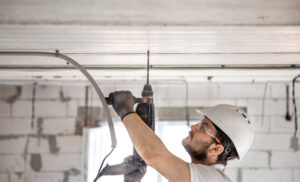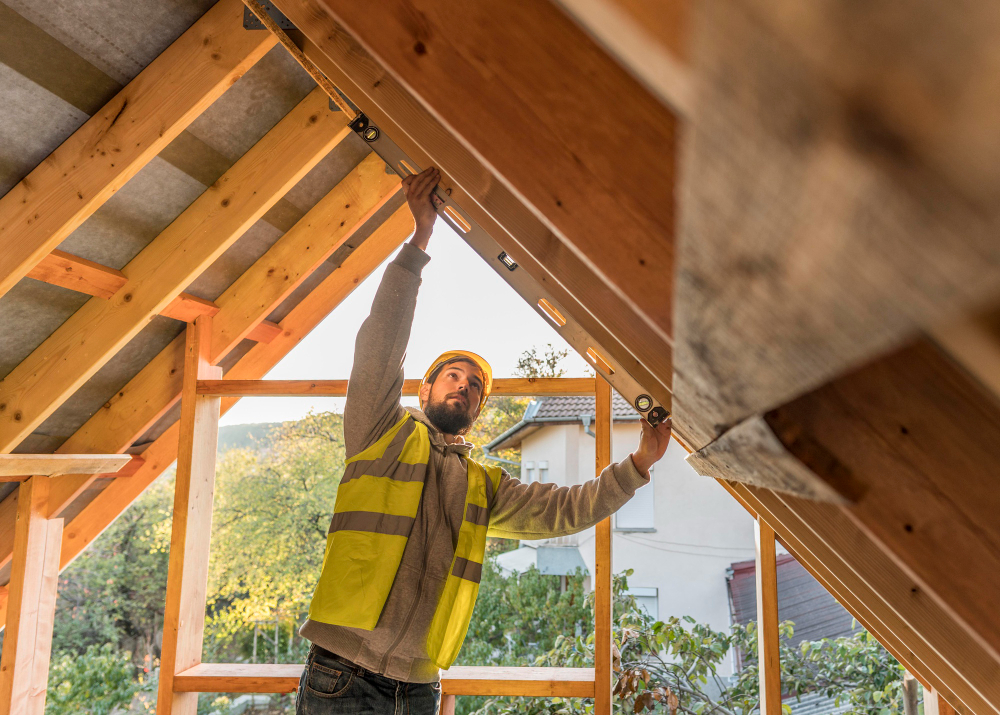Insulating your loft is an excellent DIY project to reduce heating bills, make your home cosier throughout the year and remain eco-friendly and cost-effective. Insulation offers you both cost savings and comfort!
There is an assortment of insulation materials, ranging from sheep’s wool and fibreglass insulation to foil insulation and slabs, available to choose from. Sheep’s wool insulation is popular due to its breathability, antifungal qualities, and antimicrobial qualities; however, it may be more expensive than other alternatives.

R-value
As part of your insulation or new house-building efforts, it’s crucial that you pay attention to R-value. This number measures how well insulation performs at keeping heat inside. Calculation involves using an intricate mathematical formula that takes into account the thickness, material type, and thermal conductivity of all material types. Generally speaking, higher R-values indicate better insulation performance.
To determine the R-value of your loft insulation, it’s essential that you know its thickness and thermal conductivity; both can be easily found by checking product packaging or measuring tape. Once this information is in hand, you can calculate its R-value by dividing its thickness by its thermal conductivity.
The R-value of insulation depends on several factors, including its type, thickness, density, and wetting factor. Dense materials like fibreglass or mineral wool have higher R-values than foam insulation; furthermore, its R-value can change when compressed, wetted, or otherwise damaged.
Additionally, it’s crucial that insulation be regularly checked to ensure no air leaks exist and its condition remains optimal. Gaps in insulation allow warm air to escape while cold air enters your home, which reduces its efficiency. Also, old insulation may deteriorate over time, leading to water penetration through cracks or gaps and eventual mould or fungal accumulation in gaps and crevices in old insulation panels—and it can even contribute to mould or fungal accumulation!
To improve the performance of your home, it’s essential that you select appropriate insulation according to Approved Document L of the Building Regulations and meet its minimum standards. This will ensure your building envelope is as efficient as possible while still keeping you warm, but keep in mind that the R-value only accounts for conduction; radiation or convection cannot be taken into consideration by this value alone.
Cost
Loft insulation in Glasgow is an affordable way to increase thermal efficiency in your home and reduce energy bills, as well as contribute towards protecting the environment by cutting carbon emissions. Insulation comes in various materials and installation can either be performed yourself or through professional services. Though loft insulation may cost slightly more upfront, its long-term savings make up for its expense in terms of reduced bills.
Standard loft insulation consists of rolls laid across joists. This type of insulation is generally an economical and appropriate option for most homes; prices typically range from £300 to £600 per square metre. Furthermore, this form of insulation makes an excellent solution when retrofitting older properties, as it will replace the existing insulation while maintaining its R-value.
Earth wool insulation made of recycled glass and cellulose can be found in roll form, while multifoil features multiple layers of foil with breathable foam wadding alternating them; both are popular options available commercially from various manufacturers using eco-friendly or recycled materials.
Other forms of insulation are blown fibre and sheet insulation. The former employs materials like cellulose and fibreglass blown into your loft by professionals; it may cost more than blanket insulation but may prove more cost-effective; additionally, it’s fire and moisture-proof while being covered up by plasterboard to give an attractive finish to the loft space.
Cost estimates for new insulation systems depend on how much work is involved with their installation. A professional may need to move electrical wiring, while additional cuts in insulation may need to be made around pipes or other objects in the loft space. Prices may also depend on the type of insulation material and thickness being used, as well as how large an area needs to be insulated.
Knowing the R-value and fireproof status of insulation materials is vitally important, as is understanding heat loss rates to maximise energy savings. According to government recommendations, homes should install at least 270mm of loft insulation to prevent heat loss while keeping their homes comfortable year-round; this can substantially lower energy bills as well as their carbon footprint. This investment will allow for lower heating bills and carbon footprints, as well as more comfortable lives!
Installation
An effectively insulated loft is essential to keeping heat inside and lowering energy bills, while also helping prevent condensation—an issue in many homes—and improving its value. There are various forms of insulation, from spray foam to traditional rolls, but closed-cell spray foam may be most suitable as it can be installed quickly in one go and last up to 40 years!
Before beginning the installation process, it is crucial that the loft space be cleared of anything that might obstruct laying insulation. Furthermore, it is also beneficial to check that there is adequate slack in any electrical cables running through the ceiling; otherwise, they could become covered by new insulation and pose a fire risk.
Based on your choice of insulation material, you must lay a vapour control layer, which allows a controlled amount of water vapour to pass through in warm weather. Furthermore, any services, such as pipes and wires, should be protected with airtight enclosures for airtightness.
Once the vapour control layer has been laid, insulation installation can begin. Starting at the eaves and working towards the hatch, leave 25-mm gaps between each joist. A high-density roll may provide extra resistance against sagging over time; just be careful not to compress it too tightly when installing and always leave enough room for a safe walkway.
Once you’ve installed insulation, seal any gaps and holes with filler or draft excluder to keep warm air from escaping through cracks, keeping your home cosy and warm. Also monitor energy bills regularly to see how much money has been saved by installing loft insulation; it may help lower energy costs as well as decrease carbon emissions!
Maintenance
An insulated loft can help prevent heat loss, regulate indoor temperatures, and protect against moisture intrusion, as well as help lower energy bills. While many homes already have some existing loft insulation that falls short of industry guidelines (compressed by storage boards or not being added to regularly), adding more is simple using rolls of soft insulation such as mineral wool or eco-wool; for optimal results, this should be added at least an inch higher than the original to ensure no gaps remain between insulation layers.
Before beginning insulation installation in your loft, first clear away any items stored there so as to install insulation more effectively. This will also give you a chance to ensure pipes, tanks, and wiring don’t obstruct its use. Check that any recessed lights are enclosed within airtight and fireproof enclosures (otherwise they could overheat and melt the backs of their lights).
Next, survey your loft space. Measure the average distance between joists to determine how much insulation you require; cut it with an old hand saw while still packaged and begin unrolling it on your loft area between joists horizontally or perpendicular to them—your choice. Keep to the manufacturer’s instructions by not compressing or “puffing up” the insulation; this will increase its thickness!
If you decide to install loose-fill insulation, it is advisable to wear a mask during this process. Loose-fill is a lightweight material made up of cork granules, cellulose fibre, and recycled newspaper. It is ideal for topping up existing insulation in hard-to-reach and difficult-to-access places but should never be attempted on roofs without professional guidance first.
Once installed, plasterboard can be used to provide a sleek finish and create a dry and warm space perfect for storage or play without the dry rot.
Loft Insulation Grants in Scotland
Loft insulation is one of the most cost-effective strategies to save energy and lower heating bills, cutting your usage by approximately 25%.
Many Scottish homeowners may qualify for free grants to improve home insulation through the Eco scheme, Grants Gateway can assist with determining eligibility for free.
The Energy Company Obligation Scheme is also available as a government initiative to address fuel poverty. The scheme offers grants to homeowners or private tenants making energy efficiency improvements to their property such as insulation. Furthermore, incentives exist for boiler replacements as well as measures like draft-proofing and air-source heat pumps.
The scheme is funded by six major energy suppliers, who must fund these measures to help customers save money on energy bills and cut carbon emissions. Homeowners who receive qualifying benefits and live in properties with an Energy Performance Certificate rating of D or lower can qualify to participate.
Insulating loft spaces effectively is essential to lowering energy usage and heating costs while simultaneously creating a more comfortable living space. If you are interested in applying for an ECO 4 grant, contact Eco-Home Network now and take advantage of a complimentary evaluation of your home from Eco-Home Network!
Acquiring the eco 4 grant scheme provides free loft insulation to households at risk of fuel poverty, as well as offering interest-free loans to assist householders with the costs associated with installing other energy efficiency measures, such as external wall insulation, double glazing, or a new boiler.
Grants Gateway loans are available to owner occupiers and registered private sector landlords, enabling them to make energy-saving improvements such as insulation, draft proofing, heating and renewable products or any combination thereof. These loans can be spread over an extended period with no interest being payable; those receiving income-related benefits such as Job Seekers Allowance, Employment and Support Allowance, Housing Benefit, or Pension Credit Guarantee may qualify to apply.


